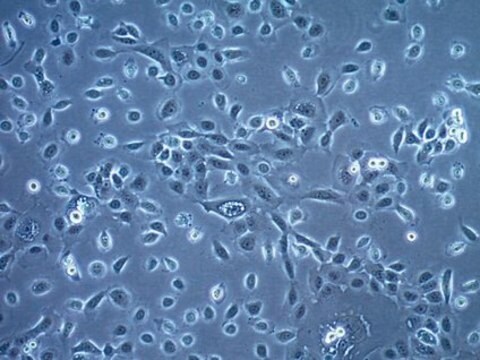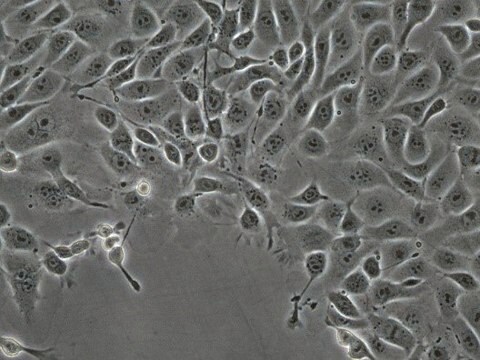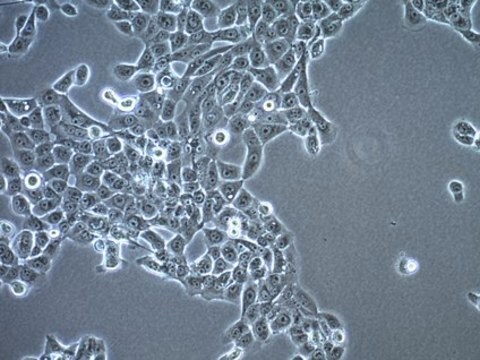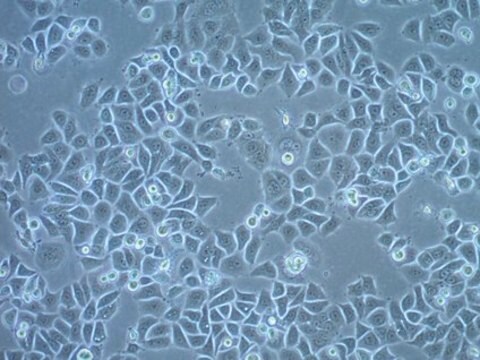推荐产品
product name
OECM-1 Human Oral Squamous Carcinoma Cell Line, OECM-1 human oral squamous carcinoma cell line is suitable for studies of cancer cell signaling, epithelial-mesenchymal transition (EMT), metastasis, invasion, and cancer cell stemness.
生物源
human
技術
cell culture | mammalian: suitable
一般說明
Squamous cell carcinoma (SCC) is a common cancer type, developing in epithelial cells. Nearly all cancers of the oral cavity are squamous cell carcinomas, and the high recurrence rate among oral SCCs make these challenging targets for therapies. Established models of this cancer type continue to yield significant insights into the properties and potential treatments of head and neck cancers .
The OECM-1 human oral cavity squamous cell carcinoma cell line is a well-established model for squamous cell carcinoma. The OECM-1 cell line harbors a missense mutation in the p53 tumor suppressor , displays low EGFR expression , and is tumorigenic in nude mice . OECM-1 cells proliferate with a doubling time of 30-38 hours and are capable of anchorage-independent growth, forming spheroid colonies . OECM-1 cells have been intensively characterized in the literature for morphology, biomarker expression and drug response .
Source:
The OECM-1 human oral cavity squamous cell carcinoma cell line was derived from surgical resection of a primary tumor of a Taiwanese male patient .
Source:
The OECM-1 human oral cavity squamous cell carcinoma cell line was derived from surgical resection of a primary tumor of a Taiwanese male patient .
細胞系描述
Cancer Cells
應用
OECM-1 human oral squamous carcinoma cell line is suitable for studies of cancer cell signaling, epithelial-mesenchymal transition (EMT), metastasis, invasion, and cancer cell stemness.
Research Category
Cancer
Cancer
This product is intended for sale and sold solely to academic institutions for internal academic research use per the terms of the “Academic Use Agreement” as detailed in the product documentation. For information regarding any other use, please contact licensing@emdmillipore.com.
品質
• Each vial contains ≥ 1X10⁶ viable cells.
• Cells are tested negative for HPV-16, HPV-18, Hepatitis A, B, C, and HIV-1 & 2 viruses by PCR.
• Cells are verified to be of human origin and negative for inter-species contamination from rat, mouse, chinese hamster, Golden Syrian hamster, and non-human primate (NHP) as assessed by a Contamination CLEAR panel by Charles River Animal Diagnostic Services.
• Cells are negative for mycoplasma contamination.
• Each lot of cells is genotyped by STR analysis to verify the unique identity of the cell line.
• Cells are tested negative for HPV-16, HPV-18, Hepatitis A, B, C, and HIV-1 & 2 viruses by PCR.
• Cells are verified to be of human origin and negative for inter-species contamination from rat, mouse, chinese hamster, Golden Syrian hamster, and non-human primate (NHP) as assessed by a Contamination CLEAR panel by Charles River Animal Diagnostic Services.
• Cells are negative for mycoplasma contamination.
• Each lot of cells is genotyped by STR analysis to verify the unique identity of the cell line.
儲存和穩定性
OECM-1 human oral cavity squamous carcinoma cell line should be stored in liquid nitrogen. The cells can be cultured for at least 10 passages after initial thawing without significantly affecting the cell marker expression and functionality.
免責聲明
Unless otherwise stated in our catalog or other company documentation accompanying the product(s), our products are intended for research use only and are not to be used for any other purpose, which includes but is not limited to, unauthorized commercial uses, in vitro diagnostic uses, ex vivo or in vivo therapeutic uses or any type of consumption or application to humans or animals.
水污染物質分類(WGK)
WGK 1
Ching-Wen Chang et al.
Cell death & disease, 9(2), 194-194 (2018-02-09)
Cancer-initiating cells (CICs) are responsible for tumor initiation, progression, and therapeutic resistance; moreover, redox homeostasis is important in regulating cancer stemness. Previously, we have identified that cancer cells containing low intracellular reactive oxygen species levels (ROSLow cells) display enhanced features
Wei Yan et al.
Frontiers in cell and developmental biology, 9, 616306-616306 (2021-04-09)
Oral squamous cell carcinoma (OSCC), accounting for two-thirds of head and neck cancer, is characterized by poor prognosis and a high rate of mortality. Exosomes have emerged as potential molecule-shuttle in intercellular communication, thereby regulating the physiological processes of recipient
我们的科学家团队拥有各种研究领域经验,包括生命科学、材料科学、化学合成、色谱、分析及许多其他领域.
联系技术服务部门








